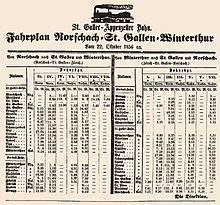St. Gallisch-Appenzell Railway



The St. Gallisch-Appenzell Railway (SGAE or SGAE) was a railway company in Switzerland . She built the Rorschach - St. Gallen - Winterthur railway line . As early as May 1, 1857, it was part of the United Swiss Railways (VSB).
St. Gallen-Appenzell Railway Association
On February 25, 1846, the St. Gallen-Appenzell Railway Association was founded in St. Gallen. The proximity of the name to the St.Gallisch-Appenzell non-profit society was obvious due to the very close connection between the two associations. The railway association created basic structural engineering and transport policy preparatory work, which also included measurements and the creation of technical and economic reports by Karl Etzel and Friedrich August von Pauli .
The line between Rorschach and Flawil proposed in 1847 is taken for granted from today's perspective. The route planned between Flawil and Winterthur was explained by rivalries between the cantons of Thurgau and St. Gallen . The Thur Valley line , which runs through flat terrain, promised the canton of Thurgau economic advantages over the St. Gallen trading center. Because of these conflicts of interest, a route was sought that circumnavigated Thurgau. If necessary, Winterthur should be reached by a pre-alpine railway via Flawil - Jonschwil - Mühlrüti through a Hulftegg tunnel to Steg im Tösstal . Other routes that have been worked out were Flawil – Jonschwil – Wil and Flawil– Niederuzwil - Henau - Züberwangen –Wil.
Concession and construction
On May 27, 1852, the St. Gallen-Appenzell Railway Company was founded. The aim of the SGAE was to build the Rorschach – St. Gallen – Winterthur with continuation to Zurich and especially to Basel . The share capital , initially calculated at CHF 12 million , soon had to be increased to CHF 14¼ million. In addition, bonds in the amount of CHF 5½ million were taken out. The canton of St. Gallen was also involved in the stock corporation . It was the first state participation in a railway in Switzerland.
While the cantons of St. Gallen and Zurich granted the concession in 1852 , the canton of Thurgau tried to prevent the line from being built. Under pressure from the Federal Assembly , the canton of Thurgau issued the concession for the Rickenbach - Wil and Wil - Sirnach - Eschlikon - Aadorf sections on March 9, 1853 .
Construction work began on May 1, 1853. The entire route was divided into four construction sections . The Wil – Winterthur section was under the direction of the well-known engineer Julius Herz . The construction of the railway included bridges over the rivers Goldach , Sitter , Glatt , Uze and Thur, which were remarkable for the times . St. Gallen was the only place to have a representative station building.
The line was opened in several stages:
- Wil – Winterthur on October 15, 1855
- Flawil – Wil on December 27, 1855
- Winkeln –Flawil on February 15, 1856
- St. Gallen – Winkeln with the Sitter Viaduct on Easter Monday, March 25, 1856
- Rorschach Hafen – Rorschach (hairpin) –St. Gallen on October 25, 1856
Merger to form the United Swiss Railways
The lack of funds for the completion of the ongoing construction work made it necessary to look for further donors. In Paris , negotiations were held in March 1856 with a finance group led by the House of Rothschild . The investors demanded a merger of the St. Gallisch-Appenzell Railway with the Glatthalbahn , the then Südostbahn and the Nordostbahn . Because the Nordostbahn could not be integrated, it was decided on September 4, 1856 to merge the remaining railways to form the United Swiss Railways (VSB).
On May 1, 1857, the VSB took over operations on the Rorschach – St.Gallen – Winterthur lines of the SGAE and Wallisellen - Uster of the Glattthalbahn. In the years 1857 to 1859 the VSB completed the continuation of the Glattthalbahn to Rapperswil and the Rorschach – St. Margrethen-Sargans-Chur , Rapperswil-Ziegelbrücke , Ziegelbrücke-Weesen-Sargans and the stitch line Weesen-Glarus .
Rolling stock
The steam locomotives Ec 2/5 of the SGAE had the following names:
| No. | Surname | later SBB no. |
|---|---|---|
| 1 | St. Gallen | 2451 |
| 2 | Appenzell | 2452 |
| 3 | Toggenburg | 2453 |
| 4th | Rorschach | 2462 |
| 5 | Wyl | 2454 |
| 6th | Flawyl | 2455 |
The locomotives built by Maschinenfabrik Esslingen according to the Engerth system in the support tender design for wood firing were ideal for the steep stretch between Rorschach and St. Gallen. The locomotives were later converted for coal firing.
See also
literature
- Anton Heer: Rorschach-St.Gallen-Winterthur: between 170 years of railway history and the future. (PDF 14.2 MB) Historical Association of the Canton of St.Gallen, 2005, accessed on February 1, 2014 .
- The St. Gallisch-Appenzell Railway from Rorschach via St. Gallen to Winterthur. (PDF 14.9 MB) Swiss Polytechnic Journal, Volume 1 (1856), Issue 3, pp. 105–107 , accessed on February 1, 2014 .
- Placid Weissenbach : The railway system in Switzerland. (PDF 14.8 MB) First part. History of the Railway System. 1913, accessed February 1, 2014 .
- St. Gallisch-Appenzell Railway. In: bahndaten.ch. Data on the Swiss railways 1847–1920. Thomas Frey and Hans-Ulrich Schiedt, ViaStoria, accessed on February 1, 2014 .
Remarks
- ^ The railway, financed with English capital, aimed to build a Lukmanier railway. It is not to be confused with today's Swiss Southeast Railway (SOB).


